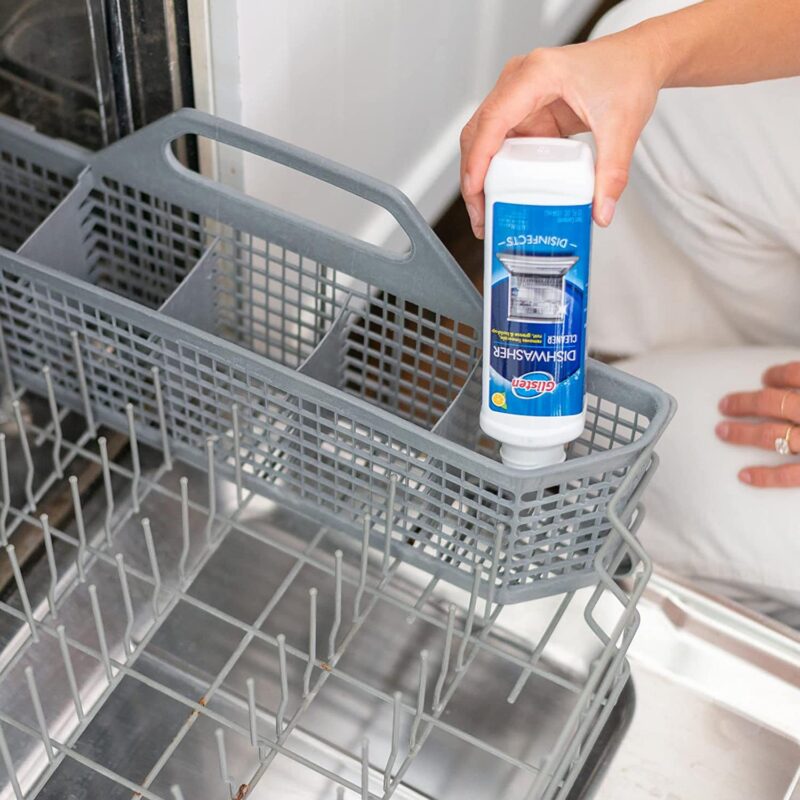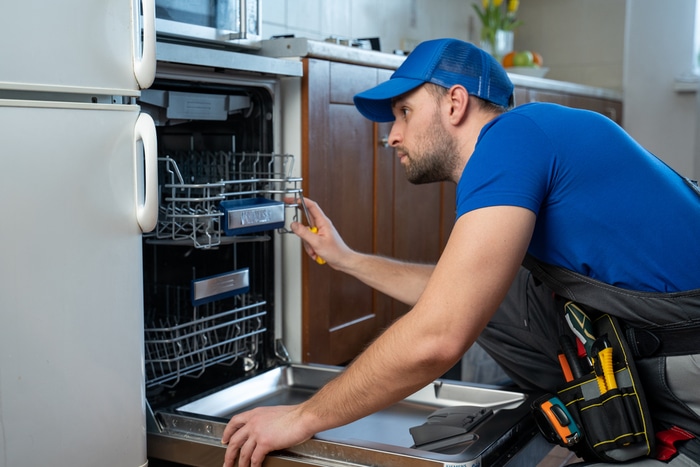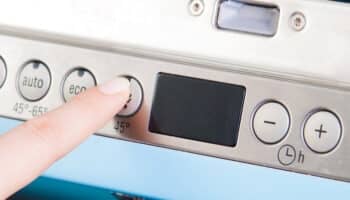Are you stuck trying to unclog a clogged dishwasher sprayer arm?
That sucks! Dishwashers are an essential part of every kitchen; without them, we’re left having to do large piles of dishes by hand.
I know how frustrating it can be to have your dishwasher spray arm clog and leave your dishes dirty – especially after a big get-together with friends or family. But don’t worry; you’ve come to the right place for answers. Below, you’ll find a list including 5 common reasons why a dishwasher’s spray arms clog and simple solutions for each one.
When your dishwasher’s spray arm is stuck or clogged, it can be due to food residue, hard water and limescale buildup, detergent residue, and foreign objects. The problem can also arise as a result of damaged or worn-out components.
Keep reading to unclog your dishwasher’s spray arm!
Why Your Dishwasher’s Spray Arm Is Stuck or Clogged
While there’s no single answer to that question, there are common culprits that typically are responsible for such an issue. The source of the problem can range from something as simple as food to detergent residue to a more complex situation involving a damaged spray arm or motor.
To help you save time, money, and effort, here are the 5 things that, in my experience, should be checked first when you notice your dishwasher’s spray arm is stuck or clogged.
#1 Food Residue
The first possible reason why your dishwasher’s spray arm is stuck or closed is food residue that has made its way all the way down into the component.
Normally, the food residue from your dirty dishes causes no issues as it flows down into your dishwasher’s chopper blade and drain pump. However, if the food chunks are too large or sticky, they might not make it all the way down to the chopper blades for processing and will stay stuck to your spray arm instead.
Over time, the collection of food residue can cause problems, so it’s important that you take a closer look at the situation.
Solution: The easiest way to check for excess food residue on your dishwasher’s spray arm is by removing the dishracks from the appliance and looking at the bottom of the unit. The spray arm normally sits at the bottom of the dishwasher, but depending on the brand and model, you might have to remove a cover to expose it.
Once you have clear access to the spray arm, carefully turn it counterclockwise (or clockwise if it has a reverse-thread screw), and remove it. Inspect it for damage and remove any leftover food or obstructions.
Note: Before doing any work on your dishwasher, please ensure it’s unplugged from the wall outlet or that power has been cut from the circuit breakers to avoid any risk of electrocution. Also, check that the water supply valve at the wall is fully closed to prevent leaks.
#2 Limescale Buildup
Excess limescale buildup is the next possible cause of a stuck or clogged dishwasher spray arm. Have you noticed that brownish substance that collects on your faucets and showerhead? It’s called limescale, and it forms due to hard water.
Hard water is a term used to describe water with high mineral content. Depending on where you live, you might deal with hard water more or less often than other people – but we all have to deal with it over time.
If you haven’t cleaned your dishwasher thoroughly in a while, it’s possible that limescale has formed in and around the spray arm and other components. I find that the simplest way to address the situation is by using a special homemade cleaning solution or a commercial cleaner.

Solution: Since limescale is usually hard to remove, you’ll need to run a couple of cycles with the right steps in order to loosen it and clean it properly. You’ll need white vinegar and baking soda. Here’s what to do:
- Place your white vinegar on the dishwasher’s top rack and run a cycle without detergent.
- When the cycle is done, sprinkle baking soda at the bottom of the dishwasher and run another cycle.
The combination of white vinegar and baking soda will not only make limescale easier to remove but also disinfect your dishwasher and eliminate any unwanted smells that persist inside it!
Note: Since limescale is present anywhere tap water is used, excess buildup of it can also affect coffee makers, steamers, and many other appliances. Feel free to use the cleaning solution mentioned above to address any limescale-related issues on your other appliances.
#3 Detergent Residue
In my experience, detergent residue can also explain why your dishwasher’s spray arm is clogged or stuck. Dishwasher detergents are specially designed to work efficiently with the appliance’s washing cycle and clean your dishes as best as possible. However, if not enough water is used or the wrong kind of detergent is chosen, it might not dissolve completely, leaving residue.
From what I’ve seen over the years, excess detergent can harden over time and make it difficult for the dishwasher to work, causing grinding noises, clogs, and more.
Solution: The simplest way to address hardened detergent on your dishwasher is by following the steps from the previous point. If you already used white vinegar and baking soda to clean your dishwasher, there’s a good chance the detergent residue has been dissolved, and everything is back to normal.
That said, if there are still detergent deposits on your spray arm, my usual advice is to remove it and manually scrub off any residue.
#4 Foreign Objects
Foreign objects can also cause your dishwasher spray arm to become clogged or get stuck. Sometimes, during a wash cycle, hard objects can fall into the spray arm and drain line (earrings, coins, and even pieces of chipped cutlery and glasses).
When said objects fall, they can cause damage to the spray arm, the chopper blade, and even the drain line, depending on how far they travel inside your dishwasher.

Solution: If you’ve already followed the steps from the previous points, your dishwasher’s spray arm is already exposed. Check that no foreign objects are preventing the spray arm from spinning on the motor bearing and that it has not sustained damage; otherwise, you’ll need to replace it and likely the motor.
To replace a damaged motor or lubricate motor bearings:
- Follow steps 1-7 of the instructions in the next section.
- Take a picture of the wiring and then disconnect the cables connecting the motor to the dishwasher.
- Undo any screws holding the bearing in place.
- Check the bearing for damage, a lack of lubricant, and debris that might be getting in the way of proper rotation.
#5 Old or Damaged Parts
The last possible reason why your dishwasher’s spray arm is stuck or clogged is that it’s at the end of its lifespan. As opposed to other household appliances, dishwashers have many components that don’t need replacement until they start causing problems – and the spray arm is one of them.
Typically, a dishwasher’s spray arm will work normally for the entirety of the appliance’s lifespan; however, sometimes, due to regular use or any of the issues mentioned above, the part will need replacing in order to keep doing its job.
Solution: Replacing an old or damaged spray arm is very easy and shouldn’t take you more than 10 minutes at the most. Here’s what you have to do:
- Unplug the dishwasher from the wall outlet or cut power to the appliance from your circuit breakers and turn off the water supply. Then, wait for the unit to cool down completely if you just used it.
- Open the dishwasher and pull out the lower dishrack.
- When you have clear access to the spray arm, turn it counterclockwise to remove it. Gunk and limescale might have formed around the spray arm enough to make it difficult to turn; if so, use a screwdriver as leverage, but be careful not to break the spray arm.
- Check the spray arm for any signs of damage and look for foreign objects that could be causing the grinding noise. If you notice the arm is damaged, you’ll need to replace it.
- You can get the replacement spray arm replacement from several vendors online by looking for it using the model part number, which can typically be found either on the spray arm itself or in your User Manual (if you no longer have the manual, please refer to our free resource below).
- When you have the new spray arm, install it where the old one was and turn it clockwise to tighten it into position.
- Put the dishwasher’s lower dishrack back into place, close the door, and run a cycle to see if the new spray arm is working normally and cleaning your dishes as it’s supposed to.
Unclogging Your Dishwasher’s Spray Arm
That about covers it!
When your dishwasher’s spray arm is either clogged or stuck, it’s natural to feel worried about the potential cost of repairs and the overall functioning of the appliance.
Luckily, as I hope this piece has helped you better understand, addressing the most common causes behind a dishwasher’s clogged or stuck spray arm can be easy and quick. More often than not, something as simple as ensuring there’s no limescale built up on the spray arm and replacing it if it’s damaged can do the trick.
Thanks for reading! If this article was useful and answered your most burning questions, please check out our other resources and free guides below and consider subscribing to our newsletter.
Have a great day!
-Craig.







